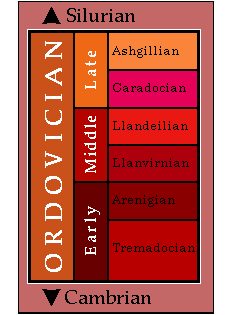







The Ordovician was named by the British geologist Charles Lapworth in 1879. He took the name from an ancient Celtic tribe, the Ordovices, renowned for its resistance to Roman domination. The epochs and series of the Ordovician each have a type location in Britain, where their characteristic faunas may be found. The age of the Ordovician boundaries were determined using potassium-argon and uranimum radiometric dating. Graptolites, extinct planktonic organisms, are most often used to correlate Ordovician strata.
The boundary between the Cambrian and the Ordovician is marked by the appearance of planktic dictyonemid graptolites. The boundary between the Ordovician and the Silurian has been designated as the base of the Parakidograptus acuminatus graptolite zone by international agreement. Dobs Linn, near Moffat, in southern Scotland is the type locality for that boundary. There, black graptolite-bearing shales are exposed.

|
Ordovician: The chart at left shows the major subdivisions of the Ordovician Period. This chart is mapped, to allow you to travel back to the Cambrian or forward to the Silurian. The Ordovician Period is part of the Paleozoic Era. |
Particularly good examples of Ordovician sequences are found in China (Yangtze Gorge Area, Hubei Province), Western Australia (Emanuel Formation, Canning Basin), Argentina (La Chilca Formation, San Juan Province), the United States (Bear River Range, Utah), and Canada (Survey Peak Formation, Alberta). Ordovician rocks over much of these areas are typified by considerable thickness of lime and other carbonate rocks that accumulated in shallow subtidal and intertidal environments. Quartzites are also present. Rocks formed from sediments deposited on the margins of Ordovician shelves are commonly dark, organic-rich mudstones which bear the remains of graptolites and may have thin seams of iron sulfide. Because graptolites are the most common fossils found in the mudstones, the appellation graptolitic facies may be used to distinguish these rocks and their contained fossils from those rocks that formed where brachiopod shells are common (i.e. the shelly facies).
Find out more about the Ordovician paleontology and geology of North America at the Paleontology Portal.


